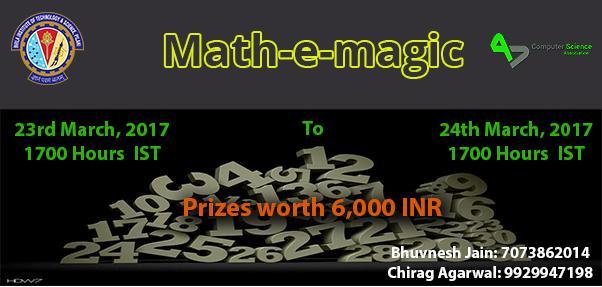Hello Codeforces community,
Get ready for an exciting Sunday action your way.
This Sunday, 17th September, from 9:30pm to 12:00am (IST) Codechef is organising Mega Cook off for ICPC aspirants from around the world.
The panel for the contest consists of :
- Problem Setter and Editorialist : likecs(Bhuvnesh Jain)
- Problem Tester : kingofnumbers(Hasan Jaddouh)
- Admin : kingofnumbers(Hasan Jaddouh)
- Russian Translator : CherryTree(Sergey Kulik)
- Mandarin Translator : huzecong(Hu Zecong)
- Vietnamese Translator : Team VNOI
- Language Verifier: (Priyank jaini)
I would also like to thank Codechef team and Praveen Dhinwa (PraveenDhinwa) for help in preparing the contest.
Hope you will enjoy solving the problems. The editorials with the model solutions will be available right aafter the contest. Please give your feedback on the problem set in the comments below after the contest.
Please find the rest of the details about the contest below.
Time: 17th September 2017 (2130 hrs) to 18th September 2017 (0000 hrs). (Indian Standard Time — +5:30 GMT) — Check your timezone.
Details: https://www.codechef.com/COOK86
Registration: You just need to have a CodeChef handle to participate. For all those, who are interested and do not have a CodeChef handle, are requested to register in order to participate.
Prizes: Top 10 school students each from Global and Indian category will get CodeChef laddus, with which the winners can claim cool CodeChef goodies. Know more here: https://www.codechef.com/laddu. (For those who have not yet got their previous winning, please send an email to [email protected]).
In addition to the above prizes, top 50 Indian students will get their ACM-ICPC expenses reimbursed. For more details refer here.
The main characters of the contest are Chef Dobby and Bhuvan.

Good Luck! Hope to see you participating!!
UPD 1: The contest starts in 25 minutes. Best of luck.
UPD2: The contest has started.
UPD3: The contest has ended. Congratulations to all the winners and also everyone who solved the complete problemset.
The global top 5 (also overall top 5) are :
tourist (Special Congratulations for completely solving the contest in just 34 minutes).
The top 5 Indians are :











